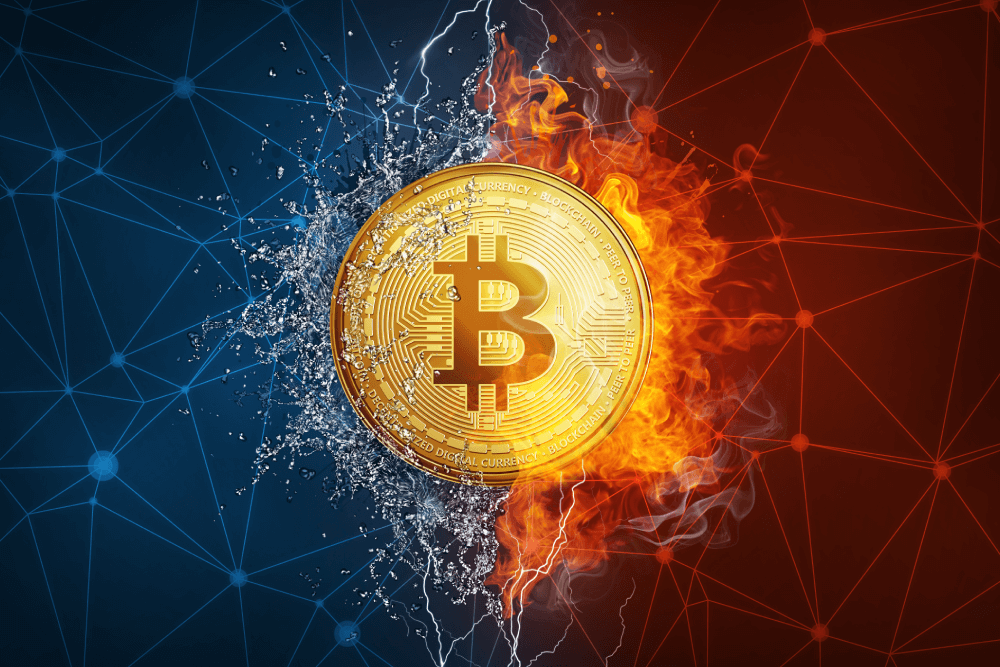What is the Difference Between Blockchain And Bitcoin?
2 July 2021
Did you know that blockchain and Bitcoin aren’t the same thing? If you’ve been using the terms interchangeably, you’re not alone; plenty of people do the same thing, probably because blockchain and Bitcoin are so closely related.

If you’ve ever scratched your head wondering what on earth is the difference between the two, this article is for you.
What is blockchain?
In super-simple terms, a blockchain is a computer file for storing data. Or, to put it in more technical jargon, it’s an open, distributed ledger (database), which means the data contained within the blockchain is distributed (duplicated) across many computers and is therefore decentralised.
This decentralisation is one of the things that makes blockchain so transformative. Unlike in a traditional, centralised database – where records are processed by one central administrator (say, a company or government) – the entire blockchain is transparent and data is verified by user consensus. Yet, despite this transparency, blockchains are incredibly secure. That’s because there’s no one central point of attack for hackers to target.
Decentralised. Distributed. This sounds a bit like Bitcoin…
You’re spot on! Blockchain is the technology that underpins Bitcoin and it was developed specifically for Bitcoin. So, Bitcoin was the first example of blockchain in action and without blockchain, there would be no Bitcoin. That’s why the two names are so often used interchangeably.
But that doesn’t mean that blockchain and Bitcoin are the same thing.
Bitcoin is a decentralised digital currency, or peer-to-peer electronic payment system, where users can anonymously transfer bitcoins without the interference of a third-party authority (like a bank or government). Bitcoin is just one example of a cryptocurrency, though; other cryptocurrency networks are also powered by blockchain technology. So although Bitcoin uses blockchain technology to trade digital currency, blockchain is more than just Bitcoin.
Looking at the wider applications of blockchain
Because blockchain and Bitcoin are so inextricably linked, it took people a long time to realise that blockchain actually has much wider applications beyond cryptocurrency networks. In fact, blockchain’s potential is so great that many people (myself included) believe the technology will revolutionise the way we do business, just like the internet did before it.
Here are just a few examples of the wider applications of blockchain beyond Bitcoin and other cryptocurrencies:
- Executing smart contracts. Thanks to Bitcoin, we already know that blockchain is great for facilitating digital transactions, but it can also be used for formalising digital relationships through smart contracts. With a smart contract, automated payments can be released once the contract terms have been fulfilled, which promises to save time and help to reduce discrepancies or solve disputes.
- Maintaining a shared, transparent system of record. Blockchain is the ideal solution for maintaining a long-term, secure and transparent record of assets (land rights would be a good example) that all parties can access securely.
- Auditing the supply chain. Blockchain allows users to trace the records of ownership for goods all the way back to the source. As an example of this, Diamond company De Beers has started to use blockchain to trace diamonds from the mine to the end customer. Anyone who wants to verify that their diamonds are free from conflict will have a transparent and complete record.
- Providing proof of insurance. Nationwide insurance company is planning to use blockchain to provide proof-of-insurance information. The tool would help police officers, insurers and customers verify insurance coverage instantly, which should help to speed up the claims process.
A quick summary of the key differences
To finish up, let’s recap why blockchain and Bitcoin are two completely separate things:
- Bitcoin is a cryptocurrency, while blockchain is a distributed database.
- Bitcoin is powered by blockchain technology, but blockchain has found many uses beyond Bitcoin.
- Bitcoin promotes anonymity, while blockchain is about transparency. To be applied in certain sectors (particularly banking), blockchain has to meet strict Know Your Customer rules.
- Bitcoin transfers currency between users, while blockchain can be used to transfer all sorts of things, including information or property ownership rights.
Where to go from here
If you would like to know more about blockchain and its applications in business, check out my articles on:
Related Articles
The Biggest Fintech Trends In The Next 10 Years
If a week is a long time in politics, then ten years is an eternity in the world of technology.[...]
5 Generative AI Chatbots Everyone Should Know About
Generative AI chatbots have rapidly become indispensable tools across various industries, transforming the way we interact with technology.[...]
AI Revolutionizes Voice Interaction: The Dawn Of A New Era In Technology
It’s becoming increasingly common to find ourselves controlling and communicating with machines using our voices.[...]
7 Ways Marketers Should Be Using Generative AI Now
Marketing is all about engaging customers with compelling content – delivering thoughtful, inspiring messages that help to create a deeper relationship with the brand.[...]
The AI Revolution In Wine Fraud Detection
In an era where authenticity is as valuable as the vintage itself, the wine industry faces a pressing challenge: wine fraud.[...]
10 Mind-Blowing Generative AI Stats Everyone Should Know About
A little over a year ago, no one was talking about generative AI. Now, it’s the dominant topic of top-level events like CES and the World Economic Forum.[...]
Sign up to Stay in Touch!
Bernard Marr is a world-renowned futurist, influencer and thought leader in the fields of business and technology, with a passion for using technology for the good of humanity.
He is a best-selling author of over 20 books, writes a regular column for Forbes and advises and coaches many of the world’s best-known organisations.
He has a combined following of 4 million people across his social media channels and newsletters and was ranked by LinkedIn as one of the top 5 business influencers in the world.
Bernard’s latest book is ‘Generative AI in Practice’.










Social Media